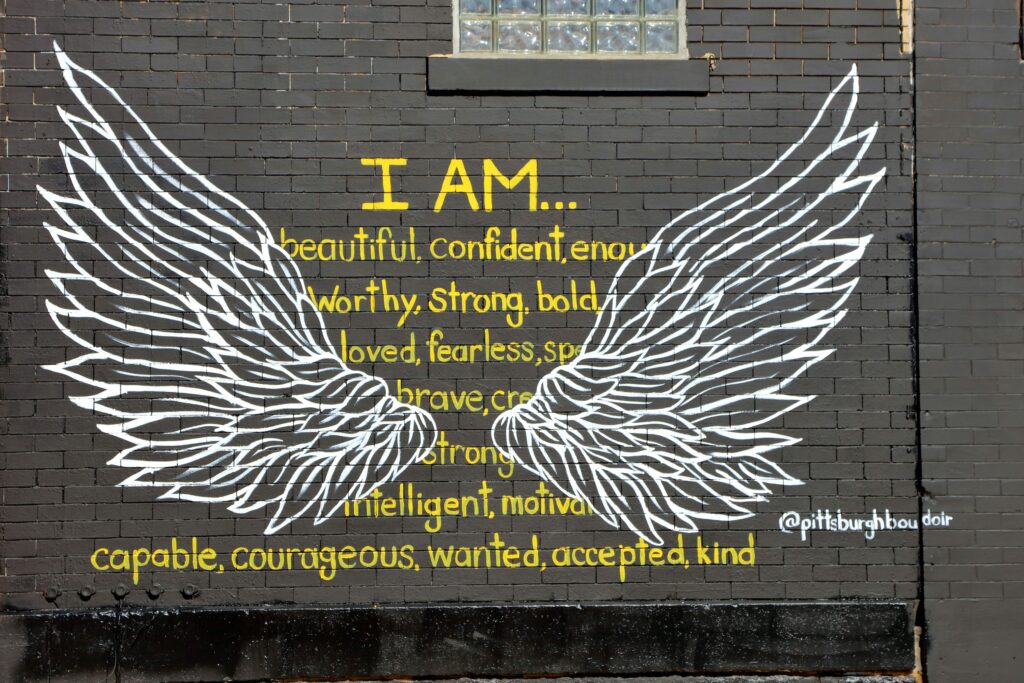By Katie Pickard, Director of Education
In the world of personal transformation, language is one of our most powerful tools. Few phrases carry as much weight as “I AM,” especially in such few words. These two simple words form the foundation of identity, belief, and self-concept.
- I am whole.
- I am complete.
- I am safe in my body.
- I am connected to all things.
- I am free from my past.
- I am enough, exactly as I am.
- I am open to healing.
In therapeutic contexts involving psychedelics, particularly in integration work, the “I AM” mantra can become a catalyst for lasting transformation. When supported by the neuroplastic potential of the brain, these affirmations help shape new neural pathways, reinforcing beliefs that align with healing, wholeness, and personal evolution.

Why “I AM” Matters in Psychedelic Therapy
Psychedelic experiences (whether with psilocybin, MDMA, ketamine, or ayahuasca) often bring forward deeply rooted emotions, memories, and insights. They can strip away ego defenses and reveal the core narratives we carry about ourselves. Often, these narratives are unconscious and unkind: “I am broken.” “I am not enough.” “I am alone.”
When these core beliefs surface during or after a psychedelic journey, the integration process becomes crucial. This is where the “I AM” mantra comes in.
“I AM” statements serve as a bridge between the transformational insight of the journey and the long-term reality we want to live. After the dissolution of ego in a psychedelic state, the mind is more open, more suggestible, and more capable of rewiring old patterns. This is known as heightened neuroplasticity: the brain’s ability to form new synaptic connections.
Research has shown that psychedelics such as psilocybin promote neurogenesis (the growth of new neurons) and increased neural connectivity. This window of plasticity is a prime time to introduce new, empowering language to guide self-perception and behavior.
The Neuroscience of Identity and Repitition
Neuroscience confirms that the words we repeat to ourselves impact the structure and function of our brains. According to Dr. Andrew Newberg, a neuroscientist and author of Words Can Change Your Brain, positive words like “peace,” “love,” and “hope” can strengthen the brain’s frontal lobe and activate motivational centers. In contrast, negative self-talk triggers stress responses and reinforces trauma pathways.
“I AM” mantras take advantage of this by anchoring identity in conscious, empowering language. When you repeat, “I am worthy,” or “I am resilient,” you’re not just saying words: you’re practicing self-directed neuroplasticity.
Over time, the repetition of these affirmations creates a feedback loop between thought and biology. As positive psychology pioneer Dr. Barbara Fredrickson found, sustained positive emotions broaden our capacity to think creatively and build resilience. By pairing “I AM” mantras with the openness that psychedelics create, individuals can move from
Common “I AM” Mantras for Transformation
The best “I AM” mantras are those that feel authentic and aspirational. Here are a few examples frequently used in therapeutic and integration settings:
- I am whole.
I am not missing pieces. Even when I feel cracked, nothing essential is lost. - I am complete.
My value does not depend on what I have or who I’m with. I carry everything I need within me. - I am safe in my body.
In this moment, I choose to trust my body. I am grounded, present, and allowed to feel at ease here. - I am connected to all things.
I am part of something greater. Nature, people, energy—I’m woven into it all. I am never truly alone. - I am free from my past.
My past may have shaped me, but it doesn’t define me. I give myself permission to grow beyond it. - I am enough, exactly as I am.
I release the pressure to be perfect. I honor who I am, right now, in all my complexity. - I am open to healing.
I don’t have to be fully healed to begin. I’m open to the process, trusting that transformation will come in its own time.
These mantras may emerge organically during a psychedelic experience, or they can be intentionally chosen as part of integration work. Journaling, repeating them aloud, writing them on mirrors, or even creating symbolic art around them can amplify their effect.
The Role of Integration and Intention
Intention-setting is a cornerstone of responsible psychedelic use. By anchoring an experience with a clear intention (like “I am healing” or “I am ready to forgive”) the brain is primed to look for congruent experiences during the journey. Post-experience, these mantras act as a guide, helping users reframe challenges and reinforce the desired identity.
Dr. Dan Siegel, a leading expert in interpersonal neurobiology, emphasizes the role of integration in creating mental health. He defines integration as the “linking of differentiated parts,” which leads to greater resilience, adaptability, and coherence in the self. “I AM” mantras provide a tool to link the insight from psychedelic states with everyday behavior, allowing a fragmented self to become more unified.
Practical Application: Using “I AM” in Daily Life
To incorporate “I AM” mantras into your psychedelic healing process, consider these steps:
- Post-Journey Reflection: After a journey, take note of themes or insights that arose. What limiting beliefs surfaced? What truths were revealed?
- Craft Your Mantra: Choose a short, present-tense “I AM” statement that affirms the reality you are moving toward.
- Repetition with Ritual: Set aside time daily to repeat the mantra. Say it aloud, write it, or meditate on it. The consistency matters more than the length of time.
- Anchor with the Body: Speak the mantra while placing your hand on your heart or belly. This creates somatic coherence between your brain and body.
Adapt and Evolve: As your healing progresses, allow your “I AM” statements to evolve with you.
Final Thoughts
Whether you’re working through trauma, reclaiming identity, or seeking alignment with your higher self, the “I AM” mantra is a simple but profound tool. When used in conjunction with psychedelic therapy and mindful integration, it helps bridge the mystical with the practical, the neurochemical with the spiritual.
“I AM” is not just a statement, it’s a declaration of becoming. In the liminal space between who you were and who you are becoming, these words shape the path ahead.
If you’re looking for personalized guidance and support before or after a psychedelic experience, the Unlimited Sciences Psychedelic Info Line offers free, 1:1 support for answering questions about psychedelic safety, integration, and emotional processing.
